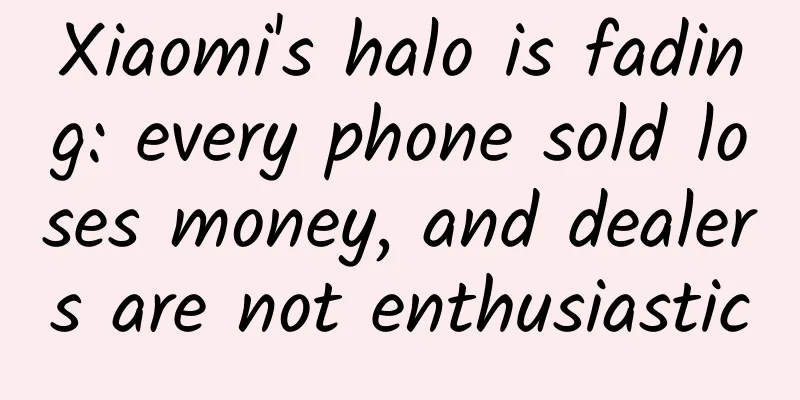Xiaomi's halo is fading: every phone sold loses money, and dealers are not enthusiastic

|
Xiaomi, which just celebrated its fifth birthday, has been hit hard. IDC recently released data showing that Xiaomi's smartphone shipments in the second quarter were 10.5 million units, down 38% from 17.1 million units in the same period last year, lagging behind Huawei, OPPO and Vivo. Although data from another agency, HIS, showed that Xiaomi's shipments did not shrink that much, still maintaining at 15.22 million units, its ranking was also overtaken by OPPO and Vivo (OV for short). Reporters have conducted on-site investigations into Xiaomi's offline channels over the past few days and found that dealers are not very enthusiastic about selling Xiaomi, while the customer flow and sales volume of the flagship experience store Xiaomi Home are far from expectations. What happened to the "idol" that was once sought after by fans? "Xiaomi is currently at the bottom of a valley," said Lei Jun, chairman of Xiaomi , at the mobilization meeting for the second entrepreneurship of the Xiaomi mobile phone department last month. It has been 49 days since Lei Jun announced on May 18 this year that he would directly manage the development and supply chain of mobile phones. Starting a business is difficult, and some executives of mobile phone companies believe that Xiaomi has problems in technology, brand, and judgment of trends. In terms of technology, it is not as well accumulated as Huawei, and the brand of "diaosi users" is weak, and the driving force of the Internet on mobile phone sales is overestimated. "It is too late to start vigorously building offline channels now." Dealers look coldly: Every Xiaomi phone sold is a loss. Earlier this year, Lei Jun expressed his hope that Xiaomi would become a world-class retail chain group, "to be the MUJI of the technology industry, and to have 1,000 Mi Home stores within 3-4 years." However, according to Xiaomi's official website, there are only 33 offline channels including Mi Home and Mi stores in mainland China, Hong Kong, Macau and Taiwan. In comparison, OV has tens of thousands of offline stores. "The proportion of mobile phone sales online has dropped from 18% to 15%." Sun Yanbiao, director of the First Mobile Phone Industry Research Institute, said. Against this background, going offline is a key topic for almost all mobile phone manufacturers this year, and Xiaomi is no exception. "It will take at least 3-5 years to build an offline channel system, and Xiaomi's accumulation is obviously insufficient." said a senior executive in the mobile phone industry. Sun Yanbiao also believes that offline products need to be diversified. "Online sales must be low-priced, but offline sales cannot be without profit margins. In addition, offline products must be differentiated to a certain extent, both domestically and internationally. Xiaomi used to sell one model worldwide, but this is no longer feasible." At present, the main offline channels come from operators and open channels, but due to the reduction of subsidies, the operator channels have declined, and open channels have become the mainstream. However, dealers are not very enthusiastic about selling Xiaomi. "Offline channels must leave a relative profit margin for retailers. The profit margin of Internet mobile phones is too low. Xiaomi is about 100 yuan, while OV and Huawei are about 400 yuan." Sun Jian, general manager of Guangdong Rediffusion Communication, a comprehensive mobile phone store, told Nandu reporters that offline stores have logistics, manpower, rental and other costs, and even issuing an invoice costs dozens of yuan. "According to the profit margins given by Xiaomi and other Internet mobile phones, we lose money every time we sell a mobile phone." Xiaomi also does not want to choose dealers. "Dealers need to increase prices to make money, so they cannot have the same price online and offline." Lin Bin, co-founder and president of Xiaomi, once told a reporter from Nandu that the directly-operated Xiaomi Home is the offline channel model they rely on. "General retail models assume fixed traffic and conversion rates to maximize the gross profit margin of each customer, while Xiaomi's directly-operated stores can do the opposite, operating at a single-digit gross profit margin and breaking even through huge traffic." As long as the daily traffic in our stores is between 1,500 and 2,000 people, this retail model can work. " However, the reporter chose the time period of 16:00-17:00 on Saturday afternoon, when the daily traffic volume is the highest, to monitor the traffic volume at the Xiaomi Home store in Guangzhou Gode Land and found that during the one-hour peak, only more than 130 people entered the Xiaomi Home, with an average stay time of 3-8 minutes. Only 3 Xiaomi mobile phones were sold in this hour. Even if calculated based on the peak customer flow on weekends and the store is open for 10 hours a day, the average customer flow of Xiaomi Home is only about 1,300 people per day, far from Lin Bin's expectations. At the same time, Nandu reporters monitored the Suning.com Zhengjia Plaza store, which had a customer flow of 160 people and sold a total of 2 Honors, 2 OPPOs and 1 Vivo. As a directly-operated store, this sales volume is far from covering the cost. Lin Bin once revealed that the Goda Land store is about 200 square meters and is staffed with about 14 workers, with rent and labor accounting for about 70% of the cost. Based on Goda Land's average rent of 30 yuan/day/square meter and an employee's salary of 7,000 yuan/month, the daily operating cost of this store is about 400,000 yuan/month. Based on a profit of 200 yuan per mobile phone, at least 2,000 mobile phones must be sold to achieve a break-even point. supply chain management: Changes in sales models bring huge challenges Every mobile phone needs a unique technical selling point. Among the "black technology" of Xiaomi 5 released in February this year, a major highlight is the 3D ceramic back cover of the premium version. However, during the "8.16" anniversary celebration when Xiaomi claimed that "there is enough stock", the premium version has been "temporarily out of stock". A Xiaomi insider once revealed that the yield rate of the ceramic back cover was too low, hovering around 10%, and even stopped production for a time. Lei Jun also admitted in a previous speech that Xiaomi's supply chain was extremely out of stock for three months this year. A netizen once revealed: "An important task in supply chain management is quality management. I was invited to visit Xiaomi's OEM factory Nanjing Innolux, and I did not see any signs of Xiaomi's involvement in quality control." In fact, according to a reporter from Nandu, Sunny Optical, which accounts for 30% of Xiaomi's camera orders, still does not have any Xiaomi quality control personnel stationed on site. A supply chain insider told Nandu reporters that Xiaomi's early reliance on supply chain management companies such as Prolutong helped it grow rapidly, but the drawbacks were also obvious. "Prolutong is like an intermediary agency, and will not go to great lengths to offend suppliers for the benefit of Xiaomi. This means there are many compromises, such as when Xiaomi wants to lower costs, Prolutong will not take the initiative to negotiate prices with suppliers, or some innovative features of Xiaomi phones cannot be implemented in a timely manner." The so-called innovation points are some unique high-tech selling points, such as the most advanced screens currently are Japanese in-Cell and Samsung AMOLED. Samsung's efforts to tilt production towards its own brand have led to restrictions on many mobile phone manufacturers, so OPPOr9 launched a non-AMOLED r9km. In May this year, Lei Jun announced that he would personally take charge of the supply chain. According to a reporter from Nandu, in the past two months, Lei Jun has visited Samsung and LG in South Korea twice to discuss screens. Samsung refused to supply them to protect its own brand, while LG was worried that Internet brands would lower the product positioning. "Xiaomi is negotiating with Shanghai Hehui, but its monthly production is only about 1.5 million." "Xiaomi used to like pre-sales, and the supply chain in Shenzhen adjusted goods on a day-to-day basis. Xiaomi's zero inventory is also based on its voice in the supply chain. However, scarce resources such as AMOLED require stocking," said Sun Yanbiao. In fact, the greater challenge for Xiaomi's supply chain management comes from the change in sales model. "In the early days, Xiaomi was very popular online, and with the pre-sale model, it could purchase two months in advance and ship directly without leaving any inventory. But now offline inventory is bound to form, and supply chain management is even more difficult," Wang Yanhui, secretary general of the Mobile Alliance, told Nandu reporters. Xiaomi now has more and more models, and the space for operational errors is bound to increase. Fan Mode Impact: Is it okay to use gold as endorsement + advertising? Regarding the completely different corporate styles of Xiaomi and OV, the fans of both sides have been engaged in a heated debate online. Xiaomi fans call OV "factory girl phones", while OV fans call Xiaomi "diaosi phones". An OV fan complained: "It's ridiculous to laugh at a 3,000 yuan phone with a 1,000 yuan diaosi phone"; while a Xiaomi fan said: "It's even more ridiculous to play games on a 3,000 yuan phone than to have a 1,000 yuan phone that lags". Although the complaints from fans of both sides continue to escalate, in the industry's view, this year OV's "east wind" has clearly overwhelmed Xiaomi's "west wind". In fact, Xiaomi's fan model of excessive pursuit of cost-effectiveness has been impacted. "It failed to make timely efforts in the layout of the industrial chain and to improve the influence of the industrial chain. When users switched from the enthusiast group to the general group, they relied too much on the price as a competitive dimension and ignored the quality and personalization dimensions." Yin Sheng, an expert from Value Line, once told the media. Another senior executive of a mobile phone company also agreed with this. Users attracted by cost-effectiveness are not loyal. "At the beginning, it was possible to attract online users by using cost-effectiveness, but this strategy is now obviously impacted by the lower-priced Meizu and LeTV. Now, Xiaomi is pursuing brand premium. Both Redmi and Xiaomi have raised their prices by 200 yuan, and the original Diaosi users have also been diverted." In addition, the single "fan model" is obviously a shortcoming. Xiaomi has recently spent a lot of money to make up for it, perhaps because it has encountered a full sense of crisis. Redmi Pro has recently started to use spokespersons and put offline building advertisements. However, a mobile phone executive told the Southern Metropolis Daily reporter that "Xiaomi may want to seek a combination of three spokespersons from different fan groups, but in the end, there may only be intersections." Meanwhile, another mobile phone manufacturer, 360, is not optimistic about Xiaomi's "all-round" approach. "At the beginning of the year, Xiaomi changed from a fever-oriented product to a black technology product. This was not a good positioning from both a marketing and branding perspective because the target audience was too broad. This time, Redmi was defined as a 'national mobile phone' and tried to make a phone that everyone would buy." Zhou Hongyi , chairman of 360 , said that the so-called hit products simply lacked core technology, "The new mobile phone landscape needs to find its own core positioning." Xiaomi's turning point is becoming increasingly obvious. Whether it will eventually fail or make a comeback, we may have the answer by the end of this year. As a winner of Toutiao's Qingyun Plan and Baijiahao's Bai+ Plan, the 2019 Baidu Digital Author of the Year, the Baijiahao's Most Popular Author in the Technology Field, the 2019 Sogou Technology and Culture Author, and the 2021 Baijiahao Quarterly Influential Creator, he has won many awards, including the 2013 Sohu Best Industry Media Person, the 2015 China New Media Entrepreneurship Competition Beijing Third Place, the 2015 Guangmang Experience Award, the 2015 China New Media Entrepreneurship Competition Finals Third Place, and the 2018 Baidu Dynamic Annual Powerful Celebrity. |
>>: Huawei Honor and Xiaomi are entering the US market: How difficult is it to survive?
Recommend
Tencent invested in Toutiao? Here are three questions
Reliable we-media outlet Kaiba broke the news tha...
How to use Tik Tok more efficiently? Master these five vertical screen thinking!
Why is it that when Chengdu sweet girl says “I th...
A collection of selected real estate advertising slogans
The editor has collected and compiled a complete ...
2021 Investment and Financial Management Fund Stock Academy Course Full Set of Convertible Bonds Hong Kong Stock IPOs Beginner to Mastery Tutorial
2021 Investment and Financial Management Fund Sto...
How to write a hot topic title? Share 5 tips!
Hot topic titles have always been one of the more...
7 Ways to Use Tik Tok for Marketing Purposes
Recently, I saw a few complaints about Douyin in ...
A complete set of live streaming script templates
First put the gains of reading this article in fr...
Zhangye wedding WeChat applet function, how much does it cost to develop a wedding WeChat applet?
As those born after 1995 and 2000 reach marriageab...
How effective is the New Year Greetings H5? Is your product suitable for H5?
The H5s made by NetEase, Tencent, and Alibaba are...
You're throwing away the most nutritious part of the celery!
Celery is a vegetable that everyone buys at home....
Warning! A woman's vision dropped to 0.1 after using expired eye drops. Don't use expired eye drops anymore!
Xiao Zhao (pseudonym), a 29-year-old female offic...
Canalys: AI-enabled PC shipments to reach 13.3 million units in the third quarter of 2024
The latest data from Canalys shows that in the th...
Youdao Dictionary Pen Professional Edition Review: Covering 2.4 million words including Oxford Advanced Learner's Dictionary, a learning tool for "study, work, and life"
For those who are learning a foreign language, th...
What should I do if I have no experience and no one to guide me?
Some classmates left me a message asking, "I...
Table Views speed up development tips
[[142938]] Before we get started, I'd like to...









